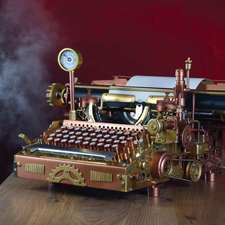Designing Keyboardio
The Making of a Keyboard

© Lead Image © 3355m, 123RF.com
Jessie Vincent, cofounder of Keyboardio, looks back at the process of designing an efficient and comfortable keyboard and some of the design decisions and challenges involved.
The Keyboardio [1] Model 01 is an open hardware success story (Figure 1). First shipped in late 2017, it has gone on to ship thousands of units, as well as developing a small but enthusiastic band of users and volunteer developers. However, this success did not come overnight. Besides the challenges that face a small and new manufacturer, the Model 01 also faced endless technical decisions about everything from the shape of the keyboard to the choice of LED switches and their position on the circuit board. Recently, Jesse Vincent, cofounder and CTO of Keyboardio, took the time to shed some light on the product development.
Ever since Vincent's first summer internship as a programmer, Vincent had found himself prone to repetitive stress injuries. "For quite a while," he remembers, "I carried a Microsoft Natural Elite keyboard in my backpack. I tended to go through three or four of them each year." Sometime in 2011 or 2012, "I discovered that there was an online community of folks who made their own keyboards. Somewhat naively, I figured I'd take a month and build myself a keyboard. Seven years later, my wife Kaia and I work full-time on keyboards."
Although keyboards remain the main device for computer input, their design has changed little in the last few decades. Although alternate keyboard layouts are available, the majority of keyboards continue to use the QWERTY layout, so-called from the left-hand top bank of keys.
[...]
Buy this article as PDF
(incl. VAT)
Buy Linux Magazine
Subscribe to our Linux Newsletters
Find Linux and Open Source Jobs
Subscribe to our ADMIN Newsletters
Support Our Work
Linux Magazine content is made possible with support from readers like you. Please consider contributing when you’ve found an article to be beneficial.

News
-
Linux Mint 22.3 Now Available with New Tools
Linux Mint 22.3 has been released with a pair of new tools for system admins and some pretty cool new features.
-
New Linux Malware Targets Cloud-Based Linux Installations
VoidLink, a new Linux malware, should be of real concern because of its stealth and customization.
-
Say Goodbye to Middle-Mouse Paste
Both Gnome and Firefox have proposed getting rid of a long-time favorite Linux feature.
-
Manjaro 26.0 Primary Desktop Environments Default to Wayland
If you want to stick with X.Org, you'll be limited to the desktop environments you can choose.
-
Mozilla Plans to AI-ify Firefox
With a new CEO in control, Mozilla is doubling down on a strategy of trust, all the while leaning into AI.
-
Gnome Says No to AI-Generated Extensions
If you're a developer wanting to create a new Gnome extension, you'd best set aside that AI code generator, because the extension team will have none of that.
-
Parrot OS Switches to KDE Plasma Desktop
Yet another distro is making the move to the KDE Plasma desktop.
-
TUXEDO Announces Gemini 17
TUXEDO Computers has released the fourth generation of its Gemini laptop with plenty of updates.
-
Two New Distros Adopt Enlightenment
MX Moksha and AV Linux 25 join ranks with Bodhi Linux and embrace the Enlightenment desktop.
-
Solus Linux 4.8 Removes Python 2
Solus Linux 4.8 has been released with the latest Linux kernel, updated desktops, and a key removal.

